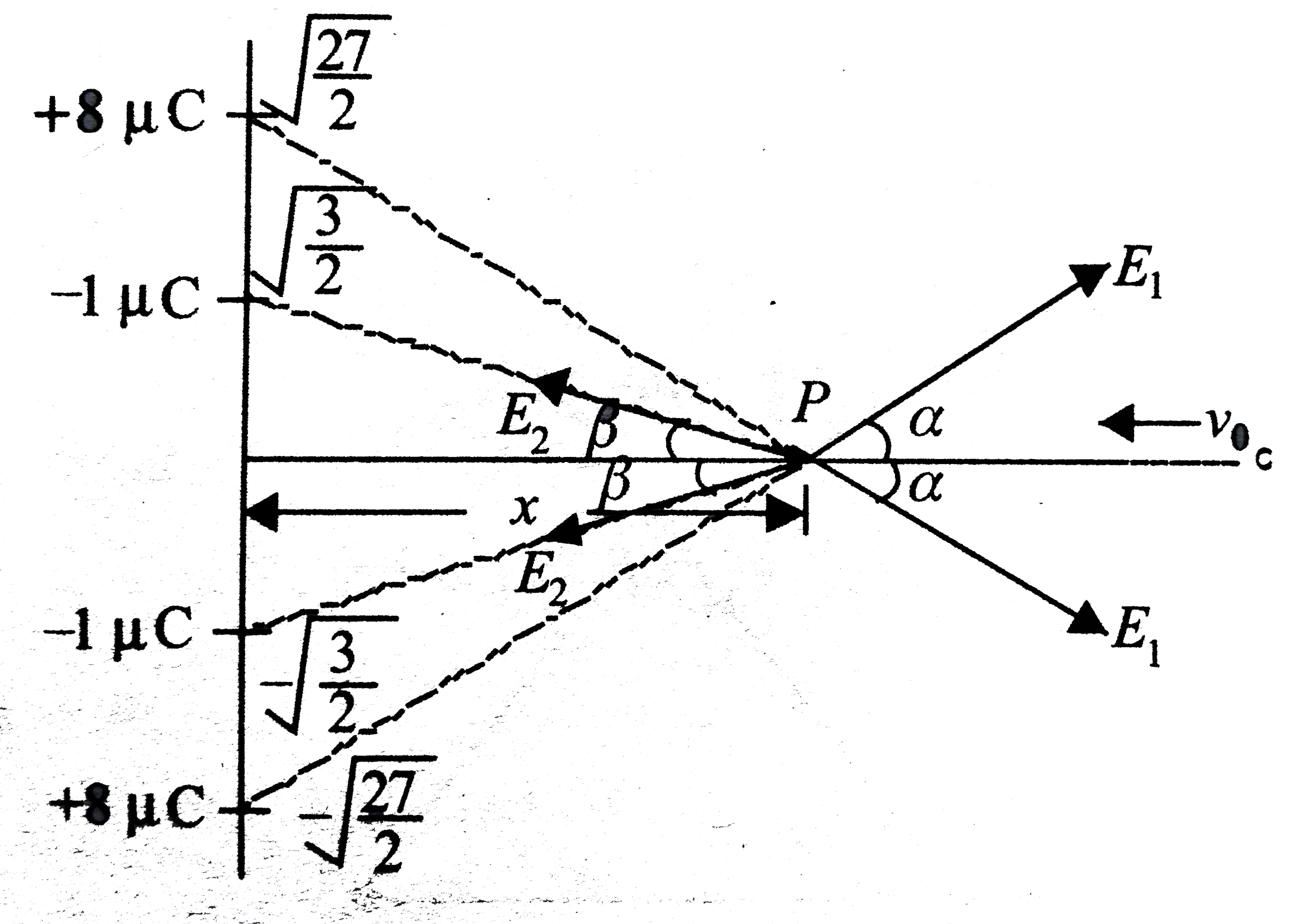Four point +8μC,−1μC,−1μC, and +8μC are fixed at the points −√27/2m,−√3/2m,+√3/2m, and +√27/2m, respectively, on the y - axis. A particle of mass 6×10−4kg and charge +0.1μC moves along the x- direction. Its speed at x=+∞ is V0. Find the least value of V0 for which the particle will cross the origin. Find also the kinetic energy of the particle at the origin. Find also the kinetic energy of the particle at the origin. Assume that space is gravity free. Given (1/4πε0)=9×109Nm2C−2.
The correct Answer is:3m/s,3×10−4J
Let electric field atv P due to all four charges be zero.
 .
.
2E1cosα=2E2cosβ
or 2k×8×10−6x(x2+27/2)3/2=2k×1×10−6x(x2+3/2)3/2 or x=√52m
Beyond P, E is toward right. To the left of P,E is toward left Once the charge crosses point P, attractive forces will pull the charge to origin. Applying conservation of energy between ∞ and P, we get
12mv20=2k⎡⎢
⎢⎣8×106√272+52−1×106√32+52⎤⎥
⎥⎦×0.1×1×106
or v0=3ms−1
To find K E at origin, apply conservation of energy between ∞ and origin.
KEx=0=2k×0.1×10−12[8√27/2−1√3/2]=12mv20
=2.5×10−4J.
Topper's Solved these Questions
- BOOK - CENGAGE PHYSICSCHAPTER - ELECTRIC POTENTIALEXERCISE - Single Correct56videos
ELECTRIC POTENTIAL
- BOOK - CENGAGE PHYSICSCHAPTER - ELECTRIC POTENTIALEXERCISE - Multiple Correct10videos
ELECTRIC POTENTIAL
- BOOK - CENGAGE PHYSICSCHAPTER - ELECTRIC POTENTIALEXERCISE - Exercise 3.39videos
ELECTRIC POTENTIAL
- BOOK - CENGAGE PHYSICSCHAPTER - ELECTRIC FLUX AND GAUSS LAWEXERCISE - MCQ s38videos
ELECTRIC FLUX AND GAUSS LAW
- BOOK - CENGAGE PHYSICSCHAPTER - ELECTRICAL MEASURING INSTRUMENTSEXERCISE - M.C.Q2videos
ELECTRICAL MEASURING INSTRUMENTS
Similar Questions
Four point charges +8mC, −mC, and +8mC are fixed at the points −√272m, −√32m, +sqrt(3/2)mand+sqrt(27/2)mrespectivelyonthey−aξs.Apartic≤ofmass6xx10^-4kgandchar≥+0.1muCmovesalongthe−xdirection.Itsspeedatx=+ooisV_0.F∈dthe≤∗valueofV_0forwhichthepartic≤willcrosstheorig∈.F∈dalsothek∈etice≠rgyofthepartic≤attheorig∈.As∑etˆspaceisgravityee.<br>Given(1)/(4piepsilon_0)=9xx10^9Nm^2//C^2.
View SolutionFour point charges +8μC,−1μC,−1μC and , +8μC are fixed at the points −√27/2m,−√3/2m,+√3/2m
and +√27/2m respectively on the y-axis. A particle of mass 6×10−4kg and +0.1μC moves along the x-direction. Its speed at x=+∞ is v0. find the least value of v0 for which the particle will cross the origin. find also the kinetic energy of the particle at the origin in tyhis case. Assume that there is no force part from electrostatic force.View Solution
Knowledge Check
- Question 1 - Select One
Electric charges of +10μC,+5μC,−3μCand+8μC are placed at the corners of a square of side √2m. The potential at the centre of the square is
A1.8VB1.8×106VC1.8×105VD1.8×104V - Question 2 - Select One
Electric charges of +10μC,+5μC,−3μC and +9μC are placed at the corners of a square of side √2m the potential at the centre of the square is
A1.8VB1.8×106VC1.8×105VD1.8×104V
Four point charges +8μC,−1μC,−1μC and , +8μC are fixed at the points −√27/2m,−√3/2m,+√3/2m
and +√27/2m respectively on the y-axis. A particle of mass 6×10−4kg and +0.1μC moves along the x-direction. Its speed at x=+∞ is v0. find the least value of v0 for which the particle will cross the origin. find also the kinetic energy of the particle at the origin in tyhis case. Assume that there is no force part from electrostatic force.View SolutionFour point charges +8μC,−1μC,−1μC and , +8μC are fixed at the points −√27/2m,−√3/2m,+√3/2m
and +√27/2m respectively on the y-axis. A particle of mass 6×10−4kg and +0.1μC moves along the x-direction. Its speed at x=+∞ is v0. find the least value of v0 for which the particle will cross the origin. find also the kinetic energy of the particle at the origin in tyhis case. Assume that there is no force part from electrostatic force.View SolutionFour point charges, +0.1 μC,-0.1 μC,-0.1 μC and +0.1 μC are kept at points A(0, 2 m), B(0, -2 m), C (-√2 m, √2 m) and D (√2 m, -√2 m) respectively. Calculate the resultant dipole moment of the combination.
View SolutionTwo point charges each 50μC are fixed on y-axis at y=+4m and y=−4m. Another charged particle having charge −50μC and mass 20g is moving along the positive x-axis. When it is at x=−3m , its speed is 20m/sec. Find the speed of charged particle when it reaches to origin. Also , find distance of charged particle from origin , when its kinetic energy becomes zero.
View SolutionTwo point charges each 50μC are fixed on y-axis at y=+4m and y=−4m. Another charged particle having charge −50μC and mass 20g is moving along the positive x-axis. When it is at x=−3m , its speed is 20m/sec. Find the speed of charged particle when it reaches to origin. Also , find distance of charged particle from origin , when its kinetic energy becomes zero.
View SolutionIdentical 50μC charges are fixed on an x axis at x=+±2.0 m. A particle of charge q=15μC is then released from rest at a point on the positive part of they axis. Due to the symmetry of the situation, the particle moves along the y axis and has kinetic energy 1.2 J as it passes through the pointx=0,y=4.0m. (a) What is the kinetic energy of the particle as it passes through the origin? (b) At what negative value of y will the particle momentarily stop?
View Solution

